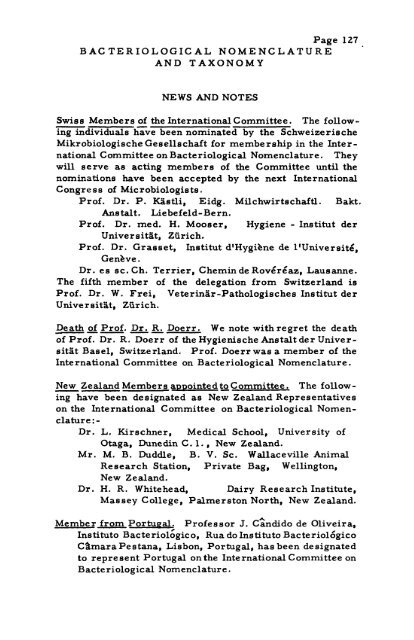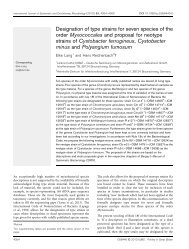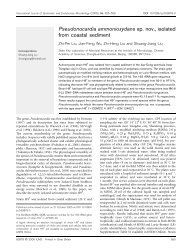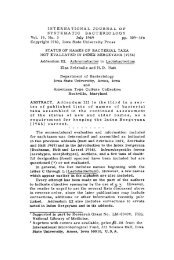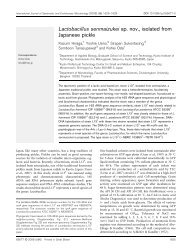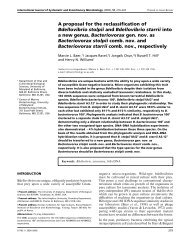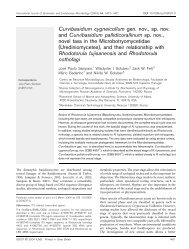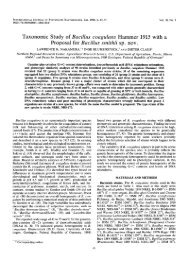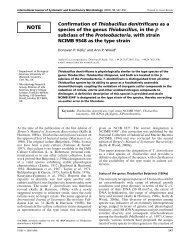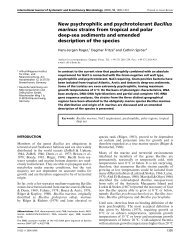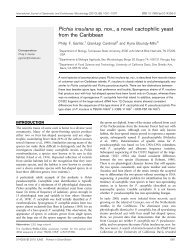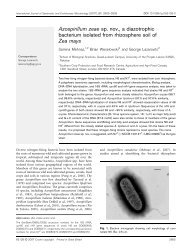Prof. Dr. W. Frei, Veterinar-Pathologisches Institut der Unive r sitst ...
Prof. Dr. W. Frei, Veterinar-Pathologisches Institut der Unive r sitst ...
Prof. Dr. W. Frei, Veterinar-Pathologisches Institut der Unive r sitst ...
Create successful ePaper yourself
Turn your PDF publications into a flip-book with our unique Google optimized e-Paper software.
-<br />
Page 127<br />
BACTERIOLOGICAL NOMENCLATURE<br />
AND TAXONOMY<br />
NEWS AND NOTES<br />
Swiss Members of the International Committee. The following<br />
individuals hyve been nominated by the Schweizerische<br />
Mikrobiologische Gesellschaft for membership in the International<br />
Committee on Bacteriological Nomenclature. They<br />
will serve as acting members of the Committee until the<br />
nominations have been accepted by the next International<br />
Congress of Microbiologists.<br />
<strong>Prof</strong>. <strong>Dr</strong>. P. mstli, Eidg. Milchwirtschaftl. Bakt,<br />
h e talt. Liebefeld-Bern.<br />
<strong>Prof</strong>. <strong>Dr</strong>. med. H, Mooser, Hygiene - <strong>Institut</strong> <strong>der</strong><br />
<strong>Unive</strong>rsitgt, Ziirich.<br />
<strong>Prof</strong>. <strong>Dr</strong>. Grasset, <strong>Institut</strong> d'Hygikne de l'<strong>Unive</strong>rsit6,<br />
Genkve.<br />
<strong>Dr</strong>. es sc. Ch. Terrier, ChemindeRovCre'az, Laueanne.<br />
The fifth member of the delegation from Switzerland is<br />
<strong>Prof</strong>. <strong>Dr</strong>. W. <strong>Frei</strong>, <strong>Veterinar</strong>-<strong>Pathologisches</strong> <strong>Institut</strong> <strong>der</strong><br />
<strong>Unive</strong> r <strong>sitst</strong>, Ziir ich.<br />
, Death - of <strong>Prof</strong>. --- <strong>Dr</strong>. R. Doerr. We note withregret the death<br />
of <strong>Prof</strong>. <strong>Dr</strong>. R. Doerr of the Hygienische Anstalt <strong>der</strong> <strong>Unive</strong>r<strong>sitst</strong><br />
Basel, Switzerland. <strong>Prof</strong>. Doerr was a member of the<br />
International Committee on Bacteriological Nomenclature.<br />
- New Zealand Members aapointed tocommittee. The following<br />
have been designated as New Zealand Representatives<br />
on the International Committee on Bacteriological Nomenclature<br />
: -<br />
<strong>Dr</strong> . L. Kirschner, Medical School, <strong>Unive</strong>rsity of<br />
Otaga, Dunedin C. 1. , New Zealand.<br />
Mr. M. B. Duddle, B. V. Sc. Wallaceville Animal<br />
Research Station, Private Bag, Wellington,<br />
New Zealand.<br />
<strong>Dr</strong>. H. R. Whitehead, Dairy Research <strong>Institut</strong>e,<br />
Massey College, Palmerston North, New Zealand.<br />
Member from Portugal; <strong>Prof</strong>essor J. C>ndido de Oliveira,<br />
<strong>Institut</strong>o Bacteriologico, Rua do Inetituto Bacteriol6gico<br />
Camara Pestana, Lisbon, Portugal, has been designated<br />
to represent Portugal on the International Committee on<br />
Bacte r iolog ic a1 Nomenclature .
Page 128<br />
INTERNATIONAL BULLETIN<br />
Addendum to Indolbildung bei Bakterien. <strong>Dr</strong>. Frieber asks<br />
that two references be added to his article,this BULLETIN<br />
p. 95. The requestcame too late for inclusion in the appro-<br />
priate place. The references to bacterial indol formation<br />
follow: -<br />
(2). Frieber, W. : Beitrzge zur Frage <strong>der</strong> hdolbildung<br />
und <strong>der</strong> Indolreaktionen sowie zur Kenntnis des<br />
Verhaltens indolnegativer Bakterien. Zbl. Bakt.<br />
I, Orig. 87. 254-277. 1921.<br />
(3). Neisser, M. und W. <strong>Frei</strong>ber. Indol- undPheno1-<br />
bildung durch Bakterien. Handbuch <strong>der</strong> mikro-<br />
biologischen Technik. Herausgegebenvon R. Kraus<br />
und P. Uhlenhuth. BandII. 1245-1265. Verlag<br />
Urban und Schwarzenberg, Berlin und Wien.<br />
-<br />
The Subcommittee on Plant Viruses authorized by the<br />
International Association of Microbiologists at the Rio de<br />
Janeiro Microbiological Congress in 1950 has the following<br />
membership:<br />
Chairman: -<br />
<strong>Dr</strong>. L. M. Black, Brooklyn Botanic Garden, 1000<br />
Washington Avenue Brooklyn 25, New York ,<br />
New York, U. S. A.<br />
Members:-<br />
<strong>Dr</strong> . F. C. Bawden, Rothams ted Experimental<br />
Station, Harpenden, Herts. , England.<br />
<strong>Dr</strong> . A. Bitancourt, <strong>Institut</strong>o Biologico, Dept. del<br />
DefesaSanitaria, CaixaPostal7119, SaoPaulo,<br />
Brazil.<br />
<strong>Dr</strong> . E. Kdhler, <strong>Institut</strong> fiir Virusforschung, Biologische<br />
Bundesanstalt fiir Land und Forstwirtschaft,<br />
Dbrnbergstrasse 25b7, Celle, Germany.<br />
<strong>Dr</strong> . B. A. Kvicala, School of Agriculture and Forestry,<br />
Brno, Czechoslovakia.<br />
<strong>Dr</strong> . H. M. Quanjer, Instituut voor Phytopathologie,<br />
Wageningen, Holland.<br />
<strong>Dr</strong> . T. H. Thung, Instituut voor Phytopathologie,<br />
Wageningen, Holland.<br />
<strong>Dr</strong> . Torsten Wike'n, <strong>Institut</strong> fiir Bakteriologie u.<br />
Garungsbiologie, Eidgenos a Techn Hoc hsc hulq<br />
<strong>Unive</strong>rsitiitstrasse 2, Ziirich 6, Switzerland.
--<br />
Page 129<br />
BAC TERIOLOGICAL NOMENCLATURE<br />
AND TAXONOMY<br />
Notice to National Microbiological Societies. Represen-<br />
tation on the International Committee on Bacteriological<br />
Nomenclature is based upon nominations made by the<br />
several national bacteriological societies. The Joint Perm-<br />
manent Secretaries of this Committee have asked that atten-<br />
tion be called to the following provision of the International<br />
Bacteriological Code of Nomenclature: -<br />
!'At least one year before each Congress eachnational<br />
society shall inform the Permanent Secretaries of any<br />
recommendations relative to change in its represen-<br />
t at i on. I t<br />
Inasmuch as the next International Congress for Micro-<br />
biology will meet in Rome in September 1953, the several<br />
societies are asked to communicate promptly with one of<br />
the Permanent Secretaries.<br />
Special Committee for Fungi. Several Special Committees<br />
on Nomenclature were appointed at the Stockholm Botan-<br />
ical Congress of 1950 to consi<strong>der</strong> the problems of nomen-<br />
clature in the several groups of plants. One of these com-<br />
mittees of special interest to microbiologists is the Special<br />
Committee for Fungi. According to Taxon &:lo, 1951) the<br />
members are as follows:-<br />
Secretary, <strong>Dr</strong>. Donald P. Rogers, New York Botanical<br />
Garden, Bronx Park, New York, U. S. A. j <strong>Dr</strong>. G. R.<br />
Bisby (Great Britain)j <strong>Dr</strong>. K. B. Boedijn (Indonesia);<br />
<strong>Dr</strong>. R. Ciferri (Italy); <strong>Dr</strong>. M. A. Donk (Indonesia);<br />
<strong>Dr</strong>. C. W. Emmons (U. S. A.)j <strong>Dr</strong>. J. W. Groves<br />
(Canada); <strong>Prof</strong>. R. Heim (France); Mr. I. Jorstad<br />
(Norway)i <strong>Dr</strong>. M. LeGal (France); <strong>Dr</strong>. J. C. Lind-<br />
quist (Sweden), <strong>Prof</strong>. W. J. Latjeharms (South Africa);<br />
<strong>Prof</strong>. G. W. Martin (U. S. A.); <strong>Prof</strong>. R. Singer<br />
(Argentine); <strong>Dr</strong>. A. Trotter (Italy); Miss E. M. Wake-<br />
field (Great Britain); and <strong>Dr</strong>. s. P. Wiltshire (Great<br />
Britain).<br />
The secretary <strong>Dr</strong>. D. P. Rogers has announced (Taxon 1:97.<br />
1952) the approval of a resolution to govern procedure in<br />
Consi<strong>der</strong>ation of generic names proposed for conservation.<br />
All proposals not t'accompanied by a detailed statement of<br />
the cases for andagainst - - - c ons e rvationl ' will be rejected.<br />
Likewise tobe rejected are "every proposal for conservation
Page 130<br />
INTERNATIONAL BULLETIN<br />
of a name that would be retained without conservation against<br />
the nomina rejicienda propositall, and "every proposal for<br />
conservation of a name that is a later homonym of a name<br />
in current use for a genus in another groupt1. For adoption<br />
of any proposal for conservation there must be an affirmat-<br />
ive vote of 60 percent of the members voting.<br />
-<br />
Taxon, the Official News Bulletin of the International association<br />
for Plant Taxonomy, Edited and Published by the<br />
International Bureau for Plant Taxonomy and Nomenclature,<br />
1 ObLange Nieuwstraat, Utrecht, Netherlands, contains many<br />
articles of interest to those who wish to keep in touch with<br />
the newer developments in botanical nomenclature. Members<br />
of the International Committee on Bacteriological Nomenclature<br />
may wish to become members of the International<br />
Association for Plant Taxonomy and thereby become subscribers<br />
to Taxon. The Annual Membership fee is $3.00 or<br />
11.4 Dutch florins. The publication appears bimonthly in<br />
issues of approximately 16 double column pages. No. 5 of<br />
Volume I was issued in May, 1952.<br />
- --<br />
The International Code of Botanical Nomenclature. 'The<br />
International Association for Plant Taxonomy has announced<br />
the publication of the revised International Code for June<br />
1952. This will make available for the first time in many<br />
years an authoritative compilation of rules and recommendations<br />
in the form finally approved by the Seventh International<br />
Botanical Congress andprepaEd by the Editorial am- mittee. The volume includes both the English and the<br />
French texts. The appearance of this publication is of consi<strong>der</strong>able<br />
interest to microbiologists. Its rules and recommendations<br />
govern nomenclature of many forms studied by<br />
microbiological techniques, particularly the fungi (including<br />
yeasts) and the algae. Furthermore the International Bacteriological<br />
Code of Nomenclature, un<strong>der</strong> the directives of<br />
the International Association of Microbiologists, has endeavored<br />
as far as the nature of the bacteria permits to be<br />
guided in formation of rules by those of Botany. Before the<br />
convening of the Rome International Congress of Microbiology<br />
in 1953 it is highly desirable that pertinent and comparable<br />
ruks and recommendations of the bacteriological and botanical<br />
codes be studiedcarefully. A review of the revised code
Page 131<br />
BACTERIOLOGICAL NOMENCLATURE<br />
AND TAXONOMY<br />
and comparison with the bacteriological code will be given<br />
in the next (October) issue of this BULLETIN. Members<br />
of the International Association for Plant Taxonomy may<br />
purchase copies for $1.60 or equivalent in other countries,<br />
non-members will pay $3.30. Outside the United States of<br />
Americacopies may be purchased through Messrs Vlaer en<br />
Kol, Utrecht, Netherlands, within the U. S. A. from <strong>Dr</strong>. R<br />
Rollins, Gray Herbarium, Harvard <strong>Unive</strong>rsity, Cambridge<br />
38, Massachusetts.<br />
Copyright of Opinions. The International Commission on<br />
Zoological-Nomenclature copyrights all of its publications,<br />
and these bear the statement "All rights reserved". The<br />
first issue of SYSTEMATIC ZOOLOGY included a discussion<br />
of this procedure. The statement is made: "The secretary<br />
of the Commission has stated that this was done to protect<br />
the financial interest of the Commission in the excess stock<br />
of these publications".<br />
Ballots were distributed by the Nomenclature Committee<br />
of the Society of Systematic Zoology to American workers<br />
to determine their reactions to this restriction upon quo-<br />
tation and use. Of those replying one approved the strict<br />
application of the rule; 9 favored the copyright but believed<br />
that the "Trust" should publicly state its permission to use<br />
short quotations of portions of opinions, etc. , in ''connec-<br />
tion with discussions of nomenclatural matters in scientific<br />
papers" 21 8 favored permitting professional quotation on<br />
application; and 106 favored complete elimination of the<br />
copyright .<br />
The results are summarized: llIt is clear that 97 percent<br />
of the persons replying, or 324 taxonomists out of 334, be-<br />
lieve that the copyright should not be used to interfere with<br />
reprinting of rules or opinions in reference works or should<br />
be eliminated entirely".<br />
The Law $ Priority in Zoology. The results of a ballot<br />
relative to the strict application of the law of priority as<br />
given in the International Zoological Code of Nomenclature<br />
is detailed in the first issue of the new Journal SYSTEMATIC<br />
ZOOLOGY. Ballots were distributed to American workers
Page 132<br />
INTERNATIONAL BULLETIN<br />
in the field of systematic zoology. Five choices were indi-<br />
cated on each ballot:- 1. Strict application of priority, with<br />
no exceptions; 2. Reasonably strict application of priority,<br />
with few exceptions that must be virtually universally ap-<br />
proved; 3. Mo<strong>der</strong>ate application of priority, with excep-<br />
tions carefully documented and approved; 4. Priority with<br />
reasonably free exceptions; 5. Usage as aguiding principle<br />
regardless of priority. The votes for the several dte-<br />
natives were 33 for 1, 119 for 2, 187 for 3, 29 for 4and<br />
3 for No. 5. The results are eummarized in the statement<br />
"it appears that 91 per cent of the taxonomists replying favor<br />
priority as a general principle, and believe thatexceptions to<br />
it ahould be at leastlimited to those fully and carefully doc-<br />
umented and receiving general approval. II


